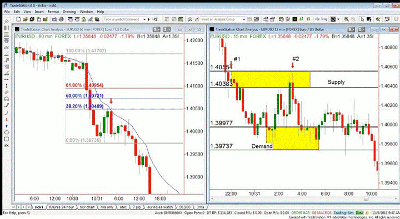Trading strategies can be split up into nearly endless combinations, but each reflects the personal preference of the trader more than being objectively right or wrong.
In my nearly 20 years in the financial industry and five years of teaching different classes for Online Trading Academy, I have seen many different trading styles and set-ups.
These different set-ups can be broken down into two different types of trades: reversals and trend following. The interesting thing about these two styles is this: A reversal trade on one timeframe is probably a trend following trade on a longer timeframe!
In the chart below, the EUR/$ pair started a sharp sell-off and retraced to its 38% Fibonacci level, also bumping into the ten-period exponential moving average. This is a very basic trend following trade.
Looking at the 15-minute chart on the right, a small supply zone appears at the red arrow labeled #1. Selling at arrow #2 would be a reversal trade using pure supply and demand on this timeframe. So, a reversal on a smaller timeframe can be a trend follower on a larger timeframe.
Now, this leads me to the “football bat.” Out there in the big, wide world of the Internet, you can find hundreds (if not thousands) of different trading set-ups using an amazing number of indicators and oscillators to help you make your trading decisions. Each of these set-ups is its own "game" with its own set of rules.
I personally have several trading set-ups that I use depending on the time of day, instrument I’m trading, and so on. What I don’t do is start one "game" and try to finish it with a different set of trading rules!
If you are using a ten-period moving average to determine your direction and possible entries for a trade, if that moving average breaks/is no longer valid, you must exit that trade! You may not change the game!
Adjusting your moving average to a 20 or a 55 to stay in the trade is changing the rules on this trade—like bringing in a bat to the third quarter of a football game. (That would be against the rules, for those of you who aren’t familiar with American football.)
Why would a trader do something like this? The only reason is to avoid taking the small loss. Small losses are your friend! They are merely a cost of doing business in trading.
Small losses keep us in the business, while large losses can blow up your trading account, or at the very least, wipe out a few days or weeks of good trading. Which means you were working in this trading business for free—which means you are doing it wrong.
In a recent trader meet-up group I led after an Online Trading Academy class, there was a lively discussion on having different trade set-ups in your arsenal. (How many metaphors will I use this week?)
One attendee was very adamant about only using supply and demand zones, and nothing else. While I can agree that properly identified areas of supply and demand are the fastest and most effective way to enter and exit trades, occasionally we may get bored with playing only that "game."
If your supply and demand zones are 200 pips apart, are you patient enough to wait a few hours until price reaches your zones? I think that with practice, most of you will be able to take trades between these obvious zones.
I have no problem taking smaller, trend following trades between my major supply and demand zones. I like playing several games, not just one!
You will hear about many different styles of trading, from a Bollinger Band gap reversal to an 89-period exponential moving average trend follower. Each style has its own set of rules and must be followed. When someone says, "That’s not how Trader X does it!" you must understand that each trader has their own preferences as to which game they prefer.
The bottom line is that every successful trader does two things in the same way—they take their small losses and let their winners run. It doesn’t matter if you are playing tennis, soccer, football, or baseball—follow the rules!
At the end of the game, the person/team with the most points wins. Take your small losses and let your winners run, and you should have more "points"/pips/ticks than you did last week.
Rick Wright is an instructor with Online Trading Academy.






















